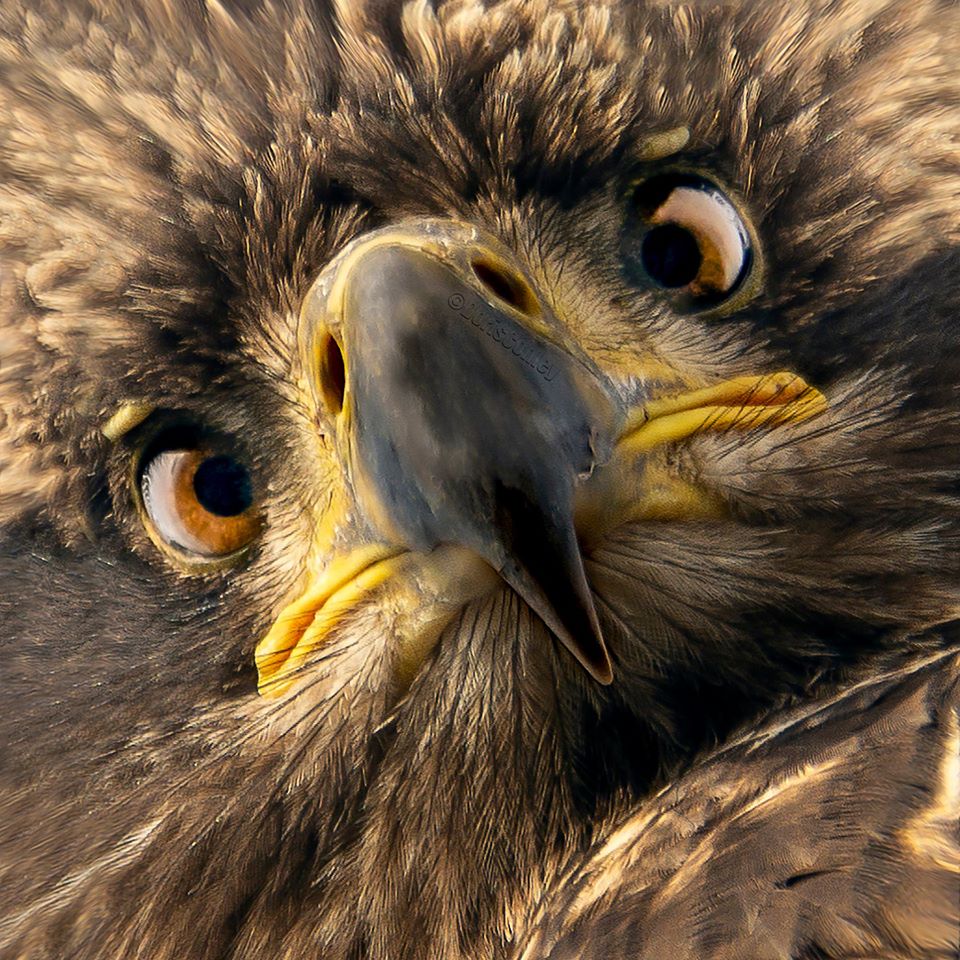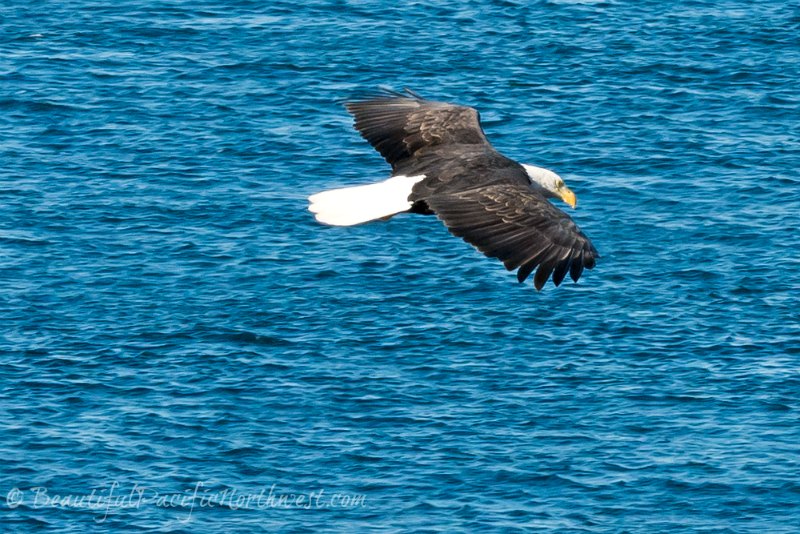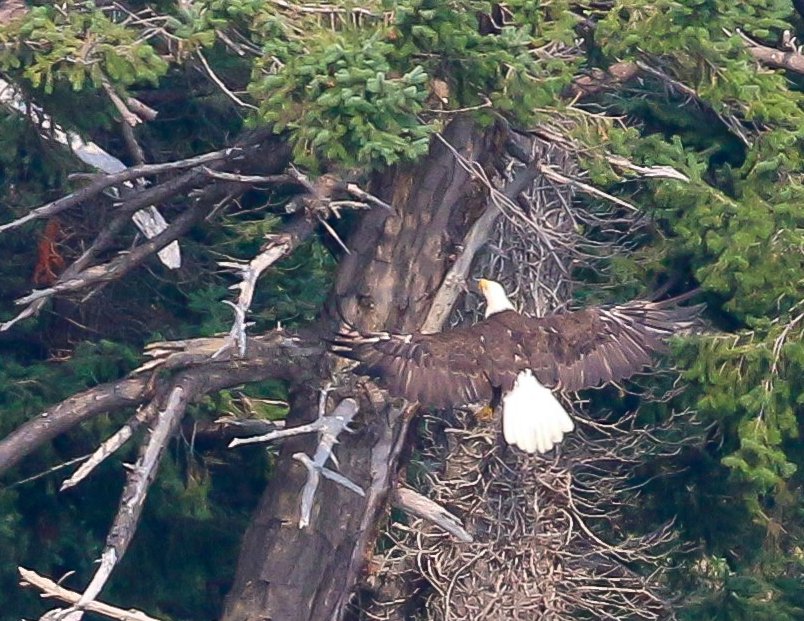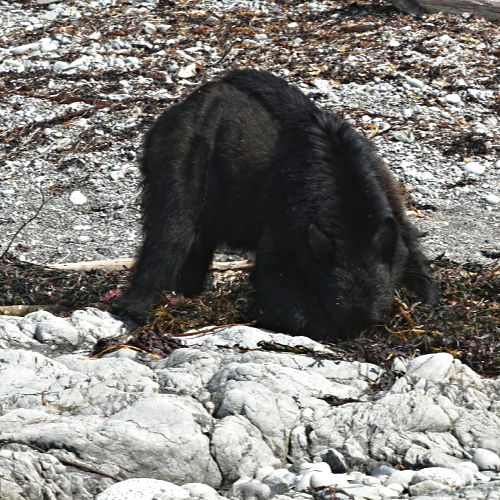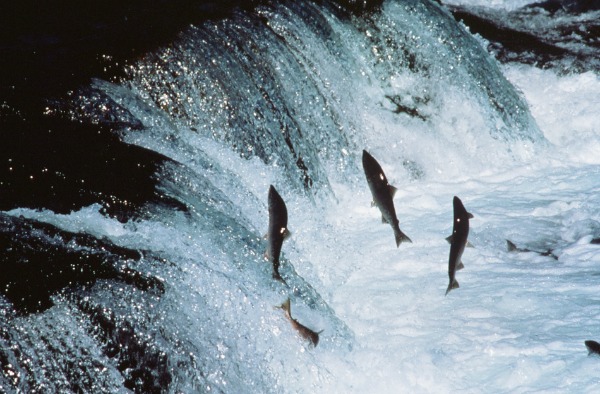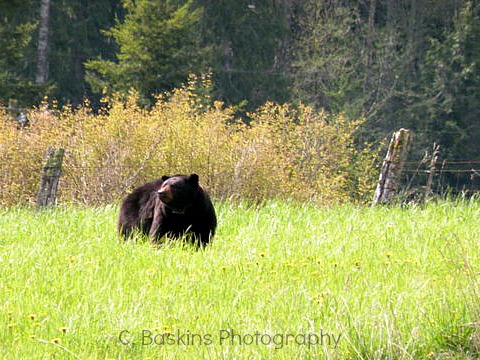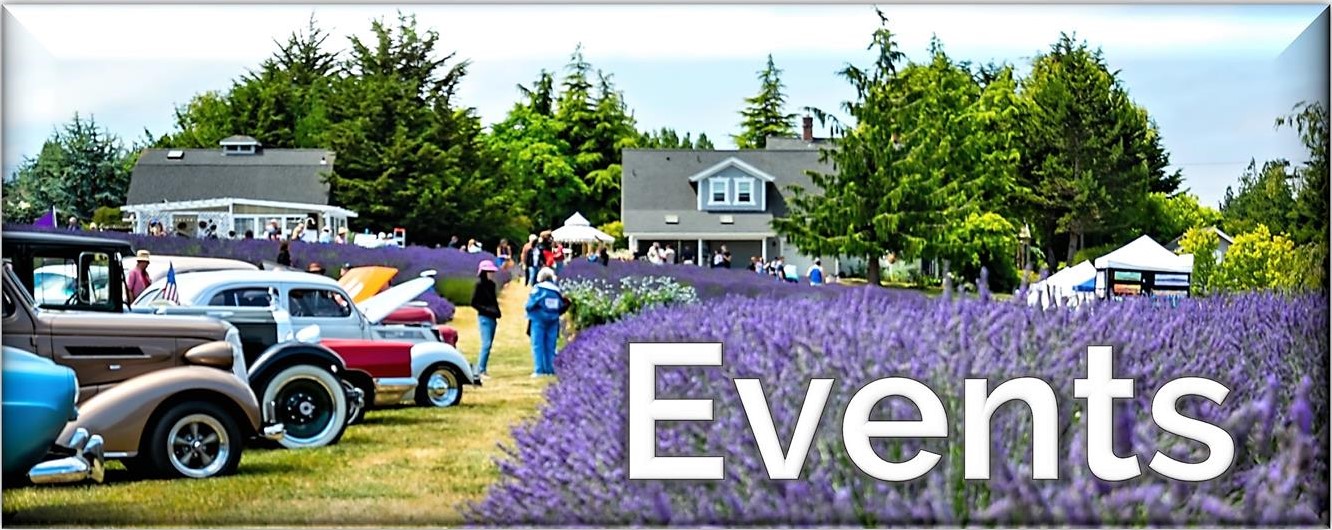Bald Eagle Facts
Bald Eagle Facts: Bald eagle information including physical characteristics, habitat, photos, history and where best to see this beautiful bird of prey.
The Bald Eagle (Haliaeetus leucocephalus) has been a symbol of America since 1782 and an important spiritual symbol for the indigenous people of North America.
Photo at right: Close up of the face of a juvenile bald eagle.
Bald eagles develop the trademark white head and white tail only after reaching maturity at around 5 years of age.
Photo Credit: Doris Conley.
Enlarge this amazing photo by clicking on it.
Or, go to Doris Conley's Facebook page to view or purchase.
General Bald Eagle Facts
Identifying bald eagles by appearance is quite simple even to a novice, if one has just a hint of what to look for. Even at a bit of a distance, the white head and white tail are dead giveaways, as bald eagles are the only species in North America with both a white head and white tail. The white plumage and chocolate brown body stand out against the blue or gray skies of the Pacific Northwest as they soar overhead, especially as they are large in comparison to most birds in North America.
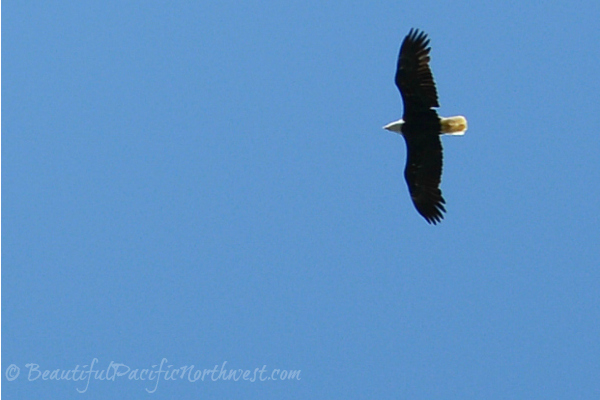 Bald eagle circles overhead in Sekiu WA.
Bald eagle circles overhead in Sekiu WA.General Bald Eagle Facts:
- Weight: The average adult male bald eagle weighs between 7-10 pounds (3.2 - 4.54 kg); the average adult female weighs up to 14 pounds (6.35 kg).
- Wingspan: An adult eagle’s wingspan grows to an average of 5.9 - 7.5 feet (1.8 - 2.3 m). A wingspan of 8 feet is not unheard-of.
- Eyesight: The actual eye of an eagle is only slightly smaller in size than a
human’s, however their keen eyesight is at least 4 times greater than a human's 20/20 vision. Hence the saying, "He has eagle eyes."
- Eggs: Bald eagles lay from one to three eggs per clutch; two eggs is usual. Incubation duties are shared by both of the parents. Eggs hatch at around thirty-four to thirty-six days.
- Maturation: The young eaglets begin flying at around ten to twelve weeks. It takes up to 5 years for the birds to gain their full adult plumage including white heads and tails. Each successive molt transitions the juvenile baldies through plumage with various levels of brown and white mottling.
At adulthood, their beaks have also transitioned from black to bright yellow, and their eyes have changed from brown to pale yellow.
Bald eagles spend the first four to five years of their lives exploring large territories and flying up to hundreds of miles per day. This continues until they reach sexual maturity and mate, at which time they will have established their territory. - Diet: Bald eagles mostly feed on live salmon and other
fish that they catch. When fish are elusive, eagles like to prey on smaller waterfowl such as ducks. Bald
eagles also feed on dead animals, most especially salmon that have completed their spawn and have died.
Here's a bit of a cowardly bald eagle fact: Rather than hunt for their meals themselves, bald eagles often let other birds catch a meal and then they pilfer the catch for themselves. Stolen prey might be rabbits, smaller birds, crabs, snakes, and fish.
- Habitat: Bald eagles are found only in North America - in Canada, the United States, and parts of Mexico. They tend to live in coastal regions or alongside larger lakes and rivers. Salmon spawning season will find many bald eagles congregating along the many creeks that serve as salmon spawning grounds.
- Nest: Eagle nests are built of branches and twigs. The hollow of the nest is lined with tiny twigs and soft down. The average bald eagle nest is 4 to 5 feet (1.22-1.52 m) in diameter and 2 to 4 feet (0.61 - 1.22 m) deep although nests can be much larger than this depending on how long they have been used. They tend to grow as time passes because the pair reuses and refreshes the nest with each season of use.
- Longevity: The average lifespan of a bald eagle living in the wild is approximately 20 years. In captivity, however, bald eagles are known to live much longer than that. For example, one captive bald eagle lived for almost 50 years at a raptor center in New York.
Bald Eagle Facts: Did You Know?
Did you know these bald eagle facts?
- Male and female bald eagles are identical in plumage; however the females are around 25% larger than the males. If you see a pair of eagles together, the bigger one is the female.
- Bald Eagles are believed to mate and remain together for life.
- When diving to snatch a fish from the water, a bald eagle’s speed can reach up to 100 mph (161 km/hr).
- During the salmon spawn, it is not unusual for bald eagles to congregate in huge numbers along the river banks of the spawning grounds. As many as 4,000 eagles might be seen in one place in some locations such as Alaska where bald eagle numbers are high.
- A bald eagle skeleton weighs only 250-300 grams, or approximately one half to two thirds of a pound. This is only 5% of their entire weight and is due to their bones being light and hollow. Beaks, talons, and feathers are all comprised of keratin, a protein that is the main structural constituent of hair, hoofs, horns, claws, and feathers.
Check out the following "Top 10 Facts" you might not have known about bald eagles!
Bald Eagle Facts: Records
The largest bald eagle nest: The most massive nest ever found was measured at 9.5 feet (2.9 meters) in diameter and 19.7 feet (6.1 meters) tall. The nest was located in St. Petersburg, Florida.
The oldest recorded wild bald eagle was at least 38 years old. It had been banded in 1977 in New York, and years later hit and killed by a car in Henrietta, New York, in June, 2015.
Interesting Bald Eagle Facts
There are very strict regulations for possessing an eagle and keeping it in captivity. You MUST have a permit to keep a bald eagle in captivity in the United States.
Most bald eagles in captivity today are permanently injured and cannot be released into the wild for their own safety. They are cared for by educational institutions with wildlife experts trained to properly care for the bald eagles. The facilities housing bald eagles are also required to be up to code with sufficient caging and equipment.
Endangered Status:
At the end of the twentieth century, the bald eagle population within the continental 48 states was on the brink of extinction. Only 450 pairs of bald eagles were known to remain. Hunting played a factor in the existential threat to bald eagles, but even after they had full legal protection in the US, the effects of DDT continued to devastate the population. The pesticide drained off the land into ponds and lakes, and was stored in the bodies of the fish they ate. Eagle eggs became thin-shelled and the hatch rate plummeted.
DDT is now illegal in the United States, and this has positively affected the bald eagle population. Since the 1970’s, bald eagle numbers have been on a steady rise. Today, over 9,500 pairs are happily soaring a mating and reproducing across North America.
The Bald eagle was removed from the U.S Government’s official “endangered species” list in June 1995 and transferred to the official “threatened” list. In June 2007 the bald eagle was placed on the "least concern" list - meaning no one is worrying any more about the survival of the species. That's a bald eagle fact that gives us a lot of joy.
Where to View Bald Eagles in the Pacific Northwest
To find bald eagles in the wild, go to places that combine water, fish, and waterfowl.
- Look along the shores of bigger rivers such as the Elwha. There is a parking area at the Elwha Bridge as Hwy 101 crosses the Elwha River. The Hoh River is another area to look, with the added bonus of possibly encountering a herd of Roosevelt elk.
- Marine Drive in the Dungeness area of Sequim - bald eagles tend to frequent this area near Dungeness Bay.
- The beach is an excellent option, especially beaches less frequented by people.
- Anywhere fishermen dock and clean their catch. Sekiu, Neah Bay, and La Push immediately come to mind.
- The Olympic National Park beaches along the Washington coast are frequented by bald eagles.
- Check with Washington Department of Fish and Wildlife, or with the rangers at Olympic National Park, who may be able to help you learn if or where salmon will be spawning during your planned visit. Where salmon spawn, there WILL be bald eagles.
Bald Eagle Facts: Significance of Bald Eagles to Native American Cultures
Bald eagles and golden eagles carry deep spiritual significance to Native Americans.
Indigenous peoples believe that the eagle is a messenger that can pass between the physical and spiritual worlds and connect humanity to the creator. Because of their beliefs, bald eagle feathers and claws are used in indigenous tribal gatherings, ceremonies and spiritual rituals.
To west coast First Nations people groups, the eagle represents leadership, strength, peace, focus and the highest possible respect. The wings of an eagle represent the balance and co-dependency between a mated pair of eagles, and the harmony that results from their combined efforts in life.
National Eagle Repository
The laws of the United States prohibit ownership of bald eagles or their parts. These same laws allow for the distribution of eagle feathers and dead eagle parts to federally recognized indigenous tribes for their use in religious spiritual and cultural ceremonies, festivals, and celebrations unique to the tribe.
There is a process to how eagle parts are distributed to the tribes. When a dead bald eagle or golden eagle has been found, The National Eagle Repository, a division of the United States Fish and Wildlife Service, is directly and singly responsible for finding, recovering, processing, preserving, storing and distributing bald and golden eagle parts and feathers to the various indigenous tribes.
Bald Eagle Facts and Legalities
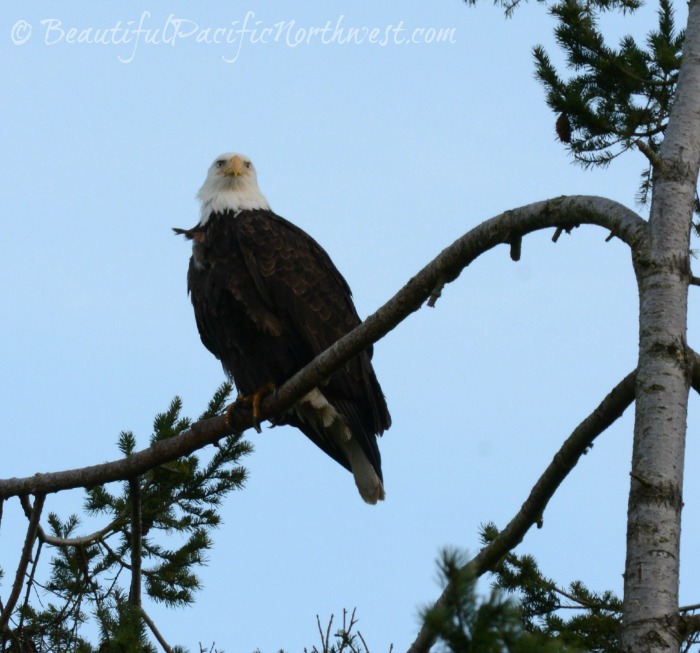 Bald eagle scans the fields and waters of Dungeness Bay from a perch near the top of a Sitka Spruce.
Bald eagle scans the fields and waters of Dungeness Bay from a perch near the top of a Sitka Spruce.You should be aware that it is ILLEGAL to buy, sell, or own a bald eagle. This includes the eagle itself, dead or alive, as well as any parts of the eagle, including its feathers.
If you see a bald eagle that is hurt or dead, you need to call either 911, or the FWS, DO NOT touch it or try to move it unless it is in danger of being hit or preyed upon. Steps to helping an injured or dead eagle can be found through The Raptor Resource Project.
Eagle Feather Laws: If you are on a beach or on a hiking trail and you see a feather that might or might not belong to an eagle, you should know that "eagle feather laws" stipulate that only native Americans of recognized tribes may own eagle feathers. The same laws provide for fines up to $250,000 should you be found in unauthorized possession of a bald eagle feather.
Tell Us Your Own Bald Eagle Story and Share Your Eagle Photos!
Do you have a great story about bald eagles or exceptional photos of them? Please share!
We'll ensure professional and amateur photographers get full credit for and links back to their work.
References:
- https://www.allaboutbirds.org/guide/Bald_Eagle/overview#
- https://en.wikipedia.org/wiki/Bald_eagle
- https://www.audubon.org/field-guide/bird/bald-eagle
- https://www.nationalgeographic.com/animals/birds/b/bald-eagle/
- http://pmdvod.nationalgeographic.com/NG_Video/437/123/160322-dc-eagle-babies-vin_FC3_dl.mp4
- https://nationalzoo.si.edu/animals/bald-eagle
- https://www.baldeagleinfo.com/
- https://www.britannica.com/animal/bald-eagle
